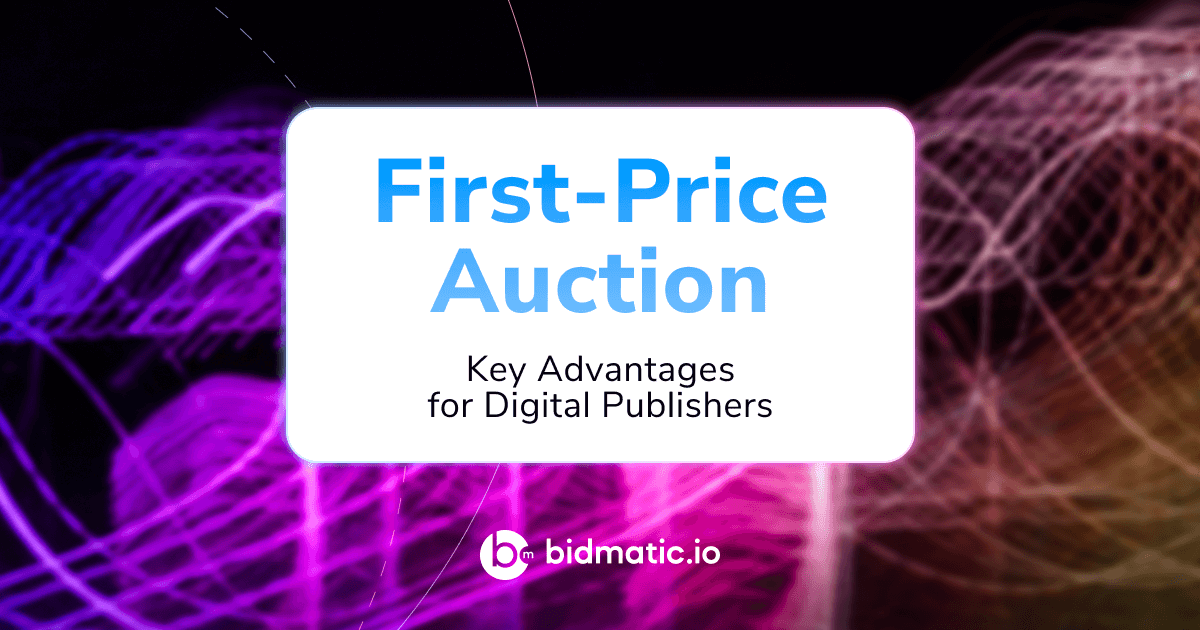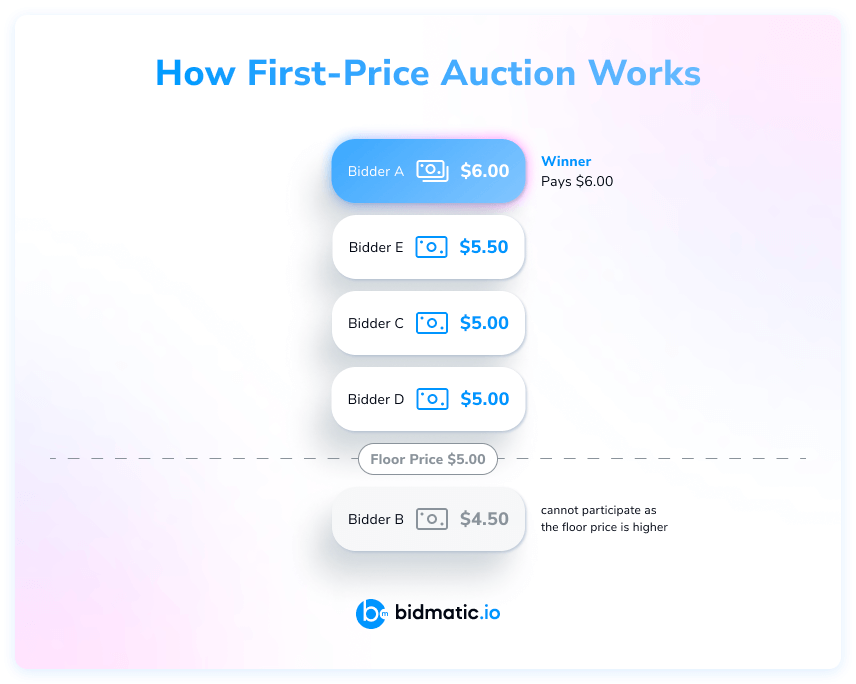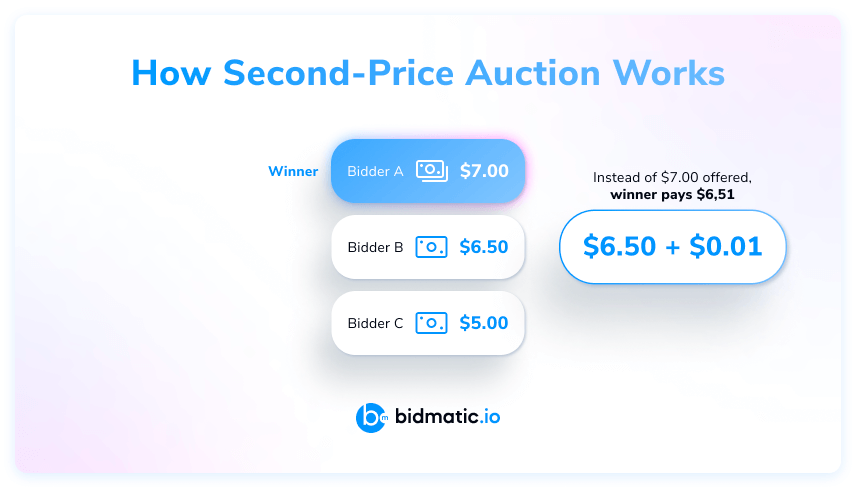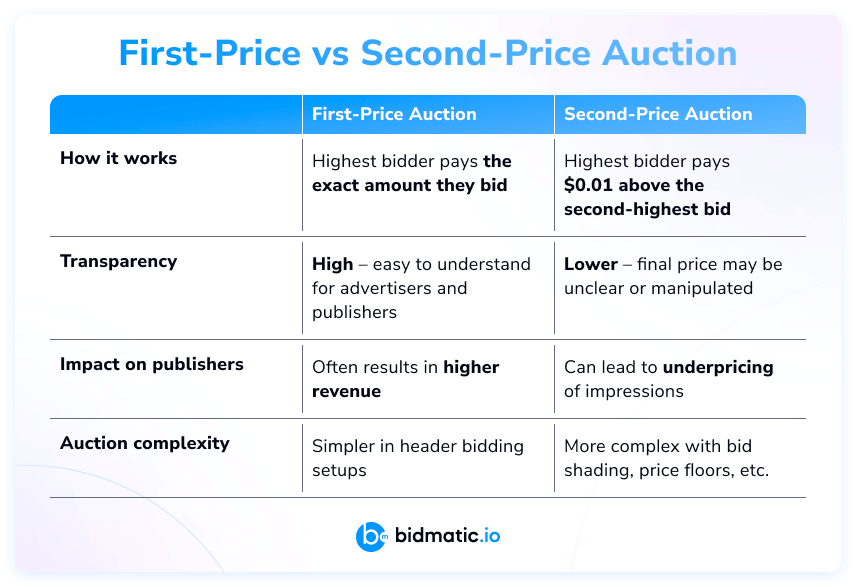
Before we define and explain how it works, let us look at the history of programmatic advertising and media buying. In 2014, the industry introduced header bidding, an advanced programmatic technology that publishers leverage to sell their ad inventory. Its key benefits are greater control and transparency over the process and the ability to choose demand partners. You can read more about the header bidding process in our blog post.
Header bidding revealed inefficiencies in second-price auctions, where publishers often earned less than advertisers were ready to pay. In contrast, first-price auctions ensured fair competition and maximum auction transparency. To address the needs of both parties, most ad management platforms, including Google Ad Manager in 2019, have shifted to this unified auction model.
It’s also important to note that when the industry was transitioning from 2nd to 1st price auctions, Google Ad Exchange used bid shading. By analyzing historical auction data, bid shading algorithms estimated the optimal bid just high enough to win without overpaying. This approach has been adopted to balance cost-efficiency for advertisers with competitiveness in Google’s real-time bidding environment.
What is a First-Price Auction
It is a type of auction that allows advertisers to bid simultaneously in real-time and, in the case of a win, pay precisely the amount they bid. In other words, the winning advertiser pays the value they believe the impression holds, dramatically reducing the complexity of an auction process.
Meanwhile, publishers selling their ad inventory can set a minimum price, known as a price floor, to determine the lowest bid they are ready to accept.
Imagine five advertisers willing to bid for publisher impressions, having the $5.00 floor price. Bidder A is ready to pay $6.00, Bidder B — $4.50, Bidder C and D — $5.00, and Bidder E offers $5.50. With the floor price set, Bidder B cannot participate in the auction, while the price of Bidders C, D, and E is lower than $6.00, meaning Bidder A gets the prize and will have to pay their $6.00.

First-Price vs. Second-Price Auction
The main distinction between a 1st-price and a 2nd-price auction lies in the pricing methodology. While in both cases, the highest bid wins, in a second-price auction, the winning advertiser pays the amount of the second-highest bidder plus 0.01$. Does it sound too complex? Check out the graphics below.

This setup often leads to strategic bidding behavior, as advertisers may attempt to manipulate the system by placing bids lower than the actual value they assign to the impression.
Let’s compare both auction models and discover why most digital publishers prefer the 1st-price model.

First-Price Auction: Key Advantages for Publishers
Let’s get right to the point. Digiday conducted research that surveyed publishers using 1st-price auctions. According to the results, 78% of them reported revenue uplift. So, returning to first-price auctions happened for a reason, and increased yields are one of them.
1. Increased Revenue Potential
In 1st-price auctions, instead of a reduced second-highest price, the winning bidder pays the exact amount they bid. It means publishers gain more of the value of their ad inventory. For example, first-price auctions can lead to 10–20% ad revenue increases for publishers, especially for high-quality or premium placements.
2. Transparent Auction Dynamics
First-price auctions offer greater transparency for both publishers and advertisers. There’s no hidden logic, bid shading, or platform-specific adjustments that obscure the final price. This clarity builds trust with advertisers and allows publishers to better understand demand patterns and optimize their pricing strategies accordingly.
3. Simplified Header Bidding Integration
In a header bidding environment, where multiple demand sources compete simultaneously, 1st-price auctions make it easier to conduct the bidding process. All demand partners bid with the same rules, simplifying comparisons and eliminating discrepancies caused by different auction models. This leads to more honest competition across SSPs and ensures publishers select the highest-value bids.
4. Stronger Competition Among Advertisers
Because buyers know their bid is the final price, 1st-price auctions incentivize more deliberate and competitive bidding. Publishers benefit from this heightened competition with stronger CPMs and reduced bid suppression.
5. Alignment with Market Trends
Major SSPs and exchanges have shifted to 1st-price auctions to match the direction of the broader programmatic ecosystem. For publishers, aligning with this trend ensures compatibility with leading monetization technologies and helps future-proof their ad monetization strategies.
The Evolution of Programmatic Advertising Auctions
Header bidding has become a turning point in the digital advertising industry and encouraged most ad management platforms, including Google Ad Manager, to get back to 1-price auctions. This shift has become highly effective for publishers willing to scale their revenue streams and streamline ad inventory management.
At Bidmatic.io, we agree that publishers opting for 1st-price auctions are monetizing their ad inventory way better than those who don’t. Owing to higher transparency and competition, they gain more control over the auction process and secure full value for each impression.
FAQs
What is bid shading?
Bid shading is a strategy media buyers use in first-price auctions to avoid overpaying. It estimates the market value of an impression based on factors like site, ad size, and competition to set the actual bid price.
How to choose a price auction type?
At first, think of what matters most to you. First-price auctions provide transparency and make ad revenue easier to predict. Meanwhile, this can lead to conservative bidding from advertisers. Second-price auctions offer more aggressive bids since the winner pays just above the second-highest offer. It can boost competition, but it also means you might not receive the full value of the highest bid.
Are unified auctions and header bidding the same?
Not exactly. Header bidding is a type of unified auction that allows publishers to collect bids from multiple demand sources simultaneously, before the ad loads. It was developed to overcome the limitations of waterfall bidding and to give non-Google buyers a fair chance against Google. While header bidding has improved competition and increased ad revenue, it can also introduce latency and technical complexity, as each demand partner must be individually integrated. Unified auctions at the ad server level aim to simplify this process further by running a single, streamlined auction.


